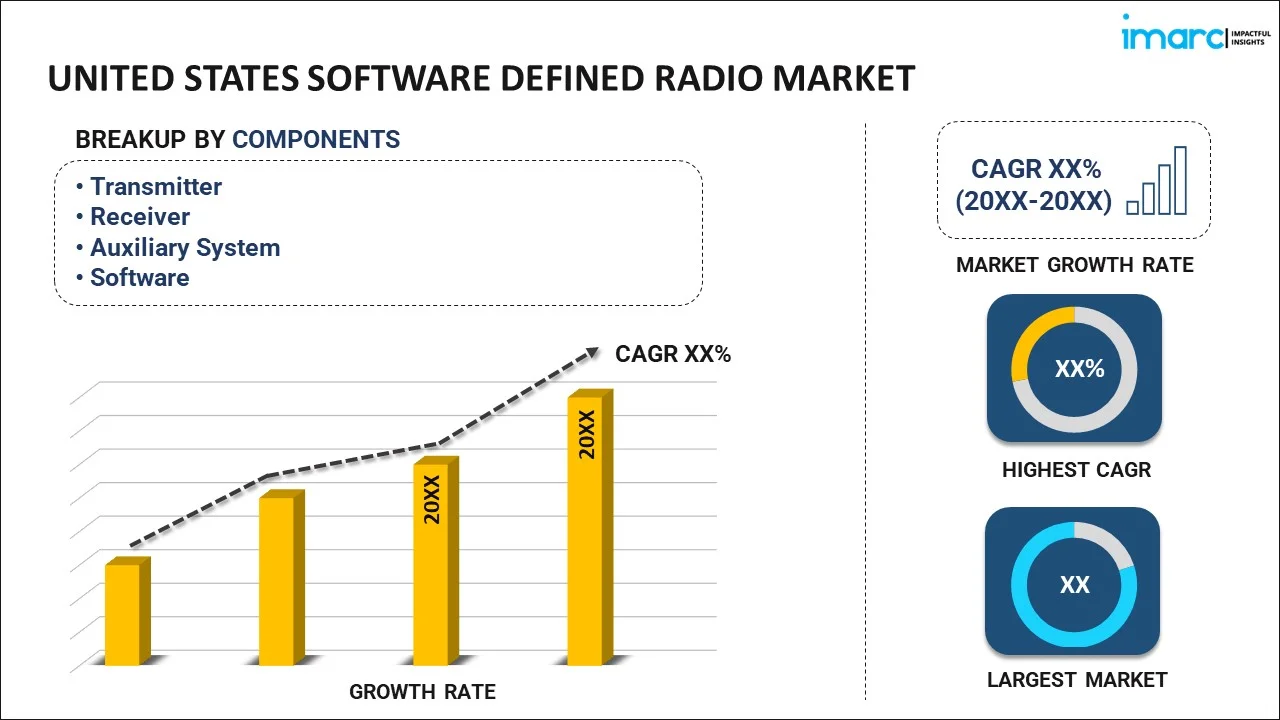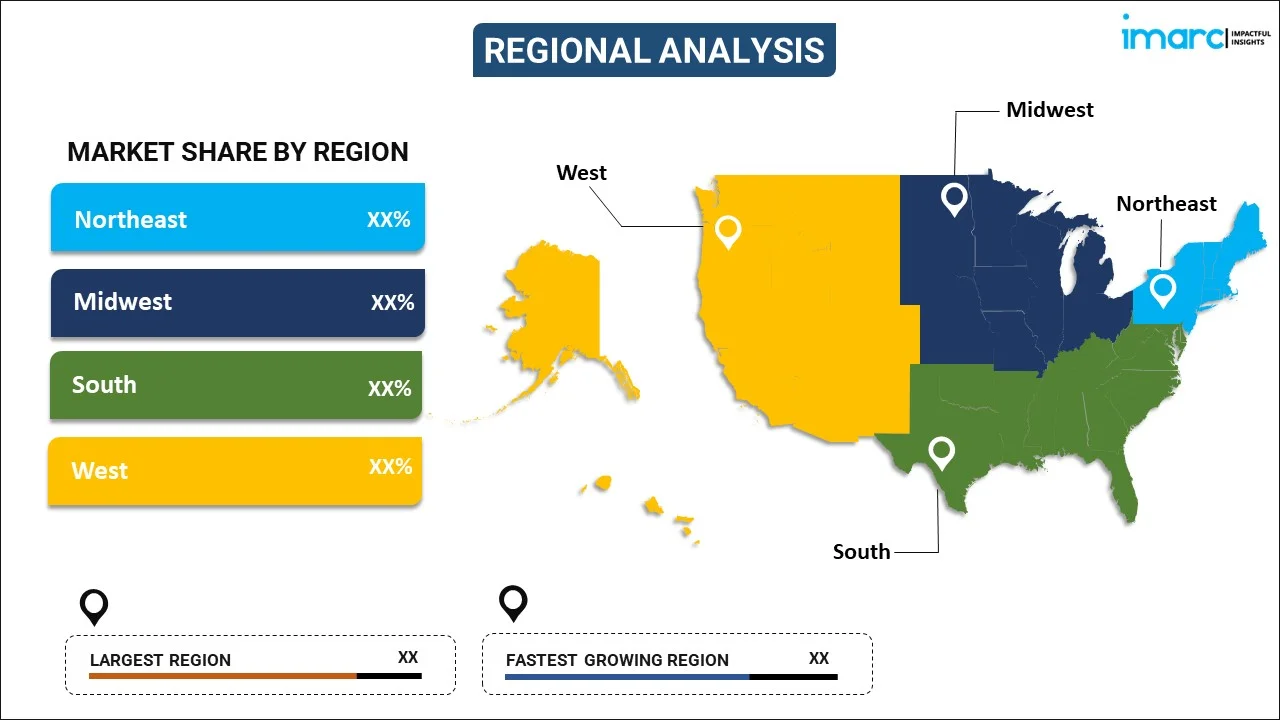
United States Software Defined Radio Market Report by Component (Transmitter, Receiver, Auxiliary System, Software), Type (Joint Tactical Radio System (JTRS), Cognitive Radio, General Purpose Radio, Terrestrial Trunked Radio (TETRA), and Others), Platform (Land, Airborne, Naval, Space), Frequency Band (High Frequency, Very High Frequency, Ultra-High Frequency, and Others), Application (Aerospace and Defense, Commercial, Telecommunication, and Others), and Region 2024-2032
Market Overview:
United States software defined radio market size is projected to exhibit a growth rate (CAGR) of 6.75% during 2024-2032. The growing investments in advanced communication systems for enhanced situational awareness are primarily driving the market growth across the country.
|
Report Attribute
|
Key Statistics
|
|---|---|
|
Base Year
|
2023 |
|
Forecast Years
|
2024-2032
|
|
Historical Years
|
2018-2023
|
| Market Growth Rate (2024-2032) | 6.75% |
The software-defined radio (SDR) is a communication tool that conducts signal-processing tasks utilizing software installed on a desktop computer. Consisting of a receiver, transmitter, software application, and additional auxiliary systems, it performs the functions of amplifiers, filters, mixers, modulators/demodulators, and detectors. The software-defined radio inherently possesses a wide frequency range and can be programmed to operate at a specific frequency within this range. Additionally, it is re-configurable, allowing it to replace multiple radios with a single unit. This characteristic provides users with increased flexibility, cost-effectiveness, and interoperability. Due to these advantages, the software-defined radio has diverse applications across industries such as aerospace, defense, telecommunications, and transportation.
United States Software Defined Radio Market Trends:
The United States software-defined radio market stands as a transformative force in the realm of communication technologies. The country is also epitomizing a cutting-edge approach where signal-processing tasks are accomplished through software on desktop computers, which is primarily driving the market growth. Comprising essential components like receivers, transmitters, software applications, and auxiliary systems, the software-defined radio seamlessly integrates functions, such as amplification, filtering, modulation/demodulation, and detection. Besides this, a notable feature of the tool is its inherent broad frequency range, coupled with the ability to be programmed for specific frequencies within this range., which is positively influencing the regional market This adaptability and re-configurability enable a single SDR unit to replace multiple radios, offering users heightened flexibility, cost-effectiveness, and interoperability, thereby acting as another significant growth-inducing factor. The United States software-defined radio market finds diverse applications across critical sectors, including aerospace, defense, telecommunications, and transportation. Moreover, as the demand for agile and adaptable communication solutions continues to rise, the United States software-defined radio market is poised for sustained growth, playing a pivotal role in advancing communication capabilities, especially in dynamic and mission-critical environments within the nation over the forecasted period.
United States Software Defined Radio Market Segmentation:
IMARC Group provides an analysis of the key trends in each segment of the market, along with forecasts at the country level for 2024-2032. Our report has categorized the market based on component, type, platform, frequency band, and application.
Component Insights:

- Transmitter
- Receiver
- Auxiliary System
- Software
The report has provided a detailed breakup and analysis of the market based on the component. This includes transmitter, receiver, auxiliary system, and software.
Type Insights:
- Joint Tactical Radio System (JTRS)
- Cognitive Radio
- General Purpose Radio
- Terrestrial Trunked Radio (TETRA)
- Others
A detailed breakup and analysis of the market based on the type have also been provided in the report. This includes joint tactical radio system (JTRS), cognitive radio, general purpose radio, terrestrial trunked radio (TETRA), and others.
Platform Insights:
- Land
- Airborne
- Naval
- Space
The report has provided a detailed breakup and analysis of the market based on the platform. This includes land, airborne, naval, and space.
Frequency Band Insights:
- High Frequency
- Very High Frequency
- Ultra-High Frequency
- Others
A detailed breakup and analysis of the market based on the frequency band have also been provided in the report. This includes high frequency, very high frequency, ultra-high frequency, and others.
Application Insights:
- Aerospace and Defense
- Commercial
- Telecommunication
- Others
The report has provided a detailed breakup and analysis of the market based on the application. This includes aerospace and defense, commercial, telecommunication, and others.
Regional Insights:

- Northeast
- Midwest
- South
- West
The report has also provided a comprehensive analysis of all the major regional markets, which include Northeast, Midwest, South, and West.
Competitive Landscape:
The market research report has also provided a comprehensive analysis of the competitive landscape. Competitive analysis such as market structure, key player positioning, top winning strategies, competitive dashboard, and company evaluation quadrant has been covered in the report. Also, detailed profiles of all major companies have been provided.
United States Software Defined Radio Market Report Coverage:
| Report Features | Details |
|---|---|
| Base Year of the Analysis | 2023 |
| Historical Period | 2018-2023 |
| Forecast Period | 2024-2032 |
| Units | US$ Million |
| Scope of the Report | Exploration of Historical and Forecast Trends, Industry Catalysts and Challenges, Segment-Wise Historical and Predictive Market Assessment:
|
| Components Covered | Transmitter, Receiver, Auxiliary System, Software |
| Types Covered | Joint Tactical Radio System (JTRS), Cognitive Radio, General Purpose Radio, Terrestrial Trunked Radio (TETRA), Others |
| Platforms Covered | Land, Airborne, Naval, Space |
| Frequency Bands Covered | High Frequency, Very High Frequency, Ultra-High Frequency, Others |
| Applications Covered | Aerospace and Defense, Commercial, Telecommunication, Others |
| Regions Covered | Northeast, Midwest, South, West |
| Customization Scope | 10% Free Customization |
| Report Price and Purchase Option | Single User License: US$ 3699 Five User License: US$ 4699 Corporate License: US$ 5699 |
| Post-Sale Analyst Support | 10-12 Weeks |
| Delivery Format | PDF and Excel through Email (We can also provide the editable version of the report in PPT/Word format on special request) |
Key Questions Answered in This Report:
- How has the United States software defined radio market performed so far and how will it perform in the coming years?
- What has been the impact of COVID-19 on the United States software defined radio market?
- What is the breakup of the United States software defined radio market on the basis of component?
- What is the breakup of the United States software defined radio market on the basis of type?
- What is the breakup of the United States software defined radio market on the basis of platform?
- What is the breakup of the United States software defined radio market on the basis of frequency band?
- What is the breakup of the United States software defined radio market on the basis of application?
- What are the various stages in the value chain of the United States software defined radio market?
- What are the key driving factors and challenges in the United States software defined radio?
- What is the structure of the United States software defined radio market and who are the key players?
- What is the degree of competition in the United States software defined radio market?
Key Benefits for Stakeholders:
- IMARC’s industry report offers a comprehensive quantitative analysis of various market segments, historical and current market trends, market forecasts, and dynamics of the United States software defined radio market from 2018-2032.
- The research report provides the latest information on the market drivers, challenges, and opportunities in the United States software defined radio market.
- Porter's five forces analysis assist stakeholders in assessing the impact of new entrants, competitive rivalry, supplier power, buyer power, and the threat of substitution. It helps stakeholders to analyze the level of competition within the United States software defined radio industry and its attractiveness.
- Competitive landscape allows stakeholders to understand their competitive environment and provides an insight into the current positions of key players in the market.
Need more help?
- Speak to our experienced analysts for insights on the current market scenarios.
- Include additional segments and countries to customize the report as per your requirement.
- Gain an unparalleled competitive advantage in your domain by understanding how to utilize the report and positively impacting your operations and revenue.
- For further assistance, please connect with our analysts.
 Inquire Before Buying
Inquire Before Buying
 Speak to an Analyst
Speak to an Analyst
 Request Brochure
Request Brochure
 Request Customization
Request Customization




.webp)




.webp)












